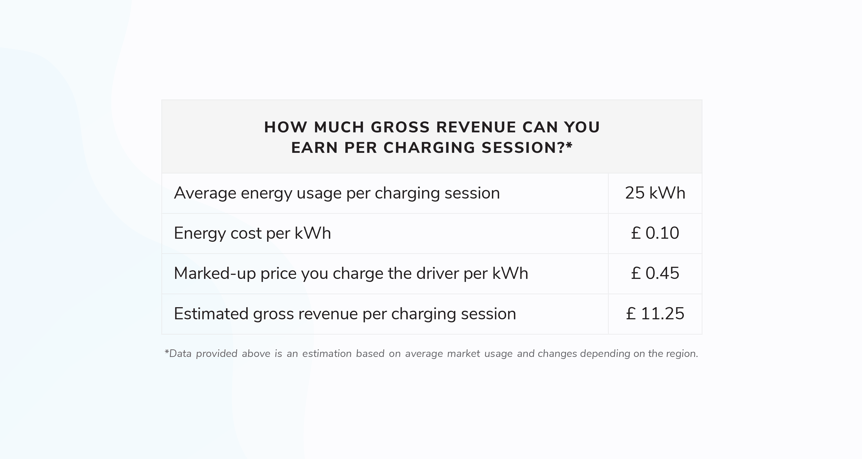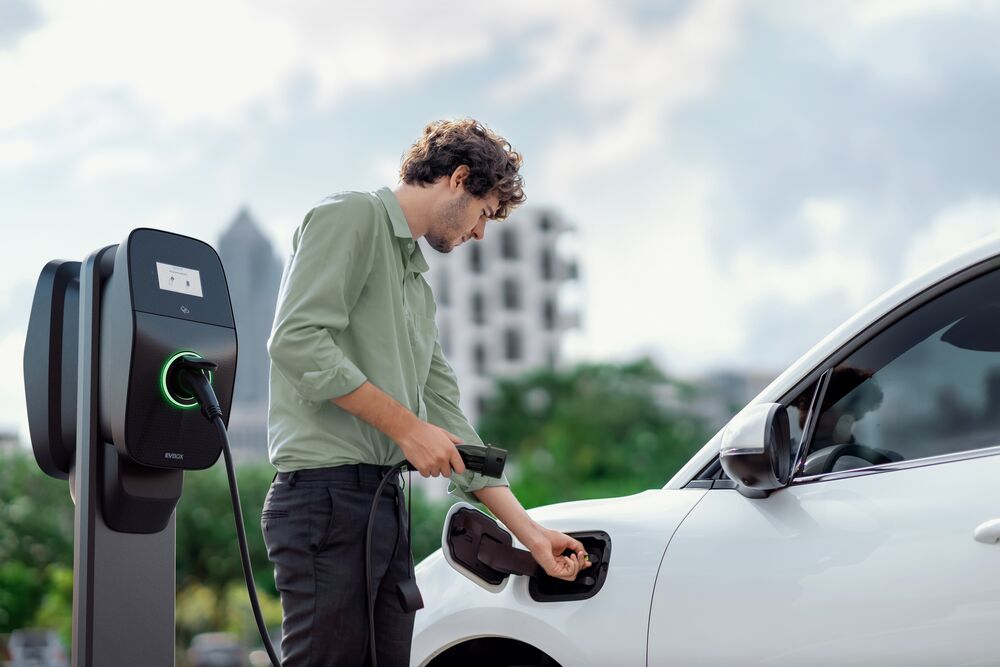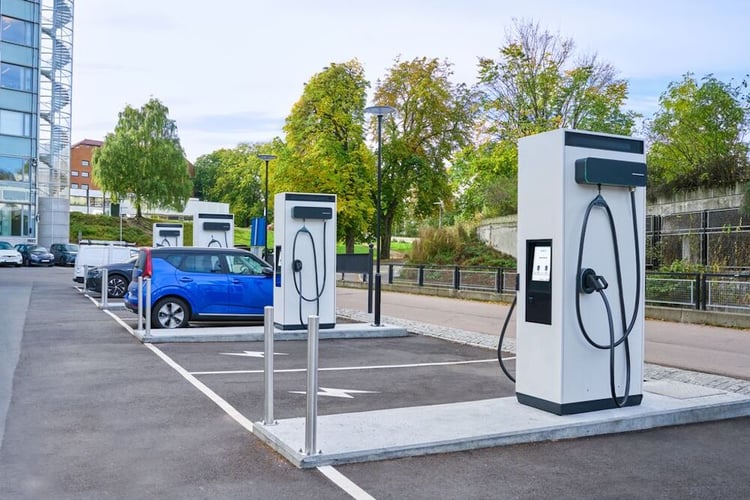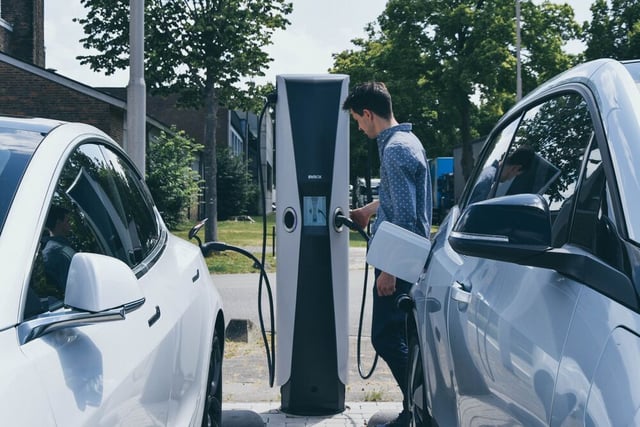
Last updated on March 24th, 2023
Broadly speaking—and depending on the needs and goals of your company—there are two main EV charging business models suitable for the workplace.
Workplace EV charging business models
1. Free EV charging at work
Employees or other eligible users have access to complimentary EV charging to
2. Workplace EV charging to generate revenue
Users pay to charge their vehicles. The fees and tariffs can differ based on the type of user and will be established by you.
For example, employees could benefit from a discounted rate, while customers and visitors could pay full price. This method has the benefit of generating additional revenue for the company and can open up the charging infrastructure to customers or visitors.
While each model has its advantages and drawbacks, which is right for your organisation will depend on several factors. This article explores the two most common EV charging business models for the workplace and explains how they could benefit your organisation.

More of your employees will start driving electric cars
Across the world, the electric vehicle (EV) market is booming, Where sales had already doubled in 2021, the sales increased further by 60 percent in 2022, surpassed the 10 million milestone for the first time, and now account for 8.3 percent of the global car market, we are unquestionably shifting towards electric mobility, and workplaces are no exception.
Many organisations that offer a company car to their employees are now looking into electrifying their fleet. Not only is this a more sustainable option, but it is also economically more viable in the long run. Indeed, while EVs seem more expensive at first glance, did you know that the total cost of ownership (TCO) of an EV is –in many cases– already lower than that of an ICE vehicle?
But even if your organisation doesn't have a fleet of its own, it can still make sense to install EV charging stations at your facility.
EV charging at work
That’s right, as people increasingly switch to electric mobility, more of your employees will inevitably start to drive electric cars. Therefore, offering EV charging at your workplace could very well help attract new talent and boost employee satisfaction.
One of the main appeals of driving an EV, is the theoretical ability to charge where and when you park, saving the trip to a gas station.
While for many drivers, home charging will be most appealing, workplaces are the runner-up in the most desired location for EV drivers to charge their vehicles.
Help employees make the switch to electric mobility
Your employees, especially those in urban areas, might not be able to get an EV charger at home. Whether it’s because they lack a personal driveway or parking space, or live in a block of flats, where getting a personal charger connected to their metre box can be challenging.
For these employees, considering switching to electric mobility is more difficult as they have to rely entirely on public charging infrastructure. With range anxiety being present combined with a current need for more charging infrastructure, many are hesitant to take the leap. The opportunity to be able to charge at work might make the difference.
That said, charging at the workplace doesn’t have to be offered as a free service, even if you offer EV charging at a discounted rate for employees, you could use it as an additional revenue stream.
But besides offering EV charging facilities to your workforce, there are even more factors to consider that might prove to be beneficial to your business.

EV charging at your workplace for visitors
Many businesses' parking lots are used to park the cars of more visitors than just their employees. Whether it’s clients, business partners, or customers, they will all increasingly drive electric and would welcome the ability to charge at your office.
Depending on the location and use of your office, it might even be worth opening up a few parking spaces to the general public and –by doing so– generating revenue from charging sessions, attracting new customers, or even both.
EV charging business models
Let’s dive into the different business models for offering EV charging at your organisation.
1. Free EV charging at work
As a workplace, you could consider offering EV charging at the workplace as an employee benefit. An employee benefit is any additional compensation offered by a company to their employees on top of their salary, or, in other words, an EVP - the employee value proposition.
Benefits are a crucial factor in attracting and retaining top talent and can help a company stand out from its competitors in the eyes of job applicants. Indeed, a study by global analytics firm Gallup found that 71% of workers consider a company’s environmental record when deciding on an employer.
Of course, offering free EV charging to your employees is not the sole solution to employee happiness, nor is it the only employee benefit your organisation should consider, but it might be the benefit your employees will truly appreciate.

2. Workplace EV charging to generate revenue
While offering EV charging as an employee benefit has its advantages, another approach is to offer charging as a paid service and even open up the stations for use by third parties. Doing so can add an additional revenue stream to the company and compensate for the price of electricity used.
Depending on the type of business and location, installing publicly-accessible EV chargers can put a business “on the map”, by directing EV drivers to them and potentially cross-selling or upselling their other offerings while their vehicle charges. Beyond guests and customers paying for charger use, companies can also offer a discounted fee for employees who want to charge their vehicles, which can still boost employee satisfaction.
Different tariffs could be suited, depending on your circumstances:
- One option is to charge users a flat rate per hour or per day, regardless of the amount of electricity consumed.
- Alternatively, users can be charged based on their energy usage, ensuring everyone pays their share.
These two approaches can also be combined by charging a fixed initial activation fee and then having users pay for the amount of electricity used. In any of these cases, employees can benefit from a discounted rate compared to visitors, or you could even set maximum time slots or available electricity for free charging.

Whether EV charging is used to generate revenue or as an employee benefit, there are some considerations businesses need to take when installing EV charging infrastructure. Especially if multiple user groups are involved, the charger needs to be able to accept different payment methods or settings, and you might want to differentiate the service based on time of day, user, or even function. This can quickly lead to growing complexity that is challenging to manage manually; in most cases, charging management software is recommended to handle all these transactions hassle-free.
Charging management system software for workplace EV charging
In today’s digital age, access to data and insights is crucial for good decision-making. Many modern charging stations are more than just a piece of hardware and offer connectivity to software management systems. A good charging management software allows you to easily manage your assets, set different charging tariffs, and learn from driver behaviour. For example, it allows businesses to easily set custom fees for different users, ranging from visitors to employees, or even distinguishing between full-time and part-time employees.

Charging management software also helps increase energy efficiency by optimising consumption. Smart charging functionalities, such as load balancing, ensure that the charging station never pulls more than the set current from the grid and that the available capacity is intelligently distributed across all charging stations.
When it comes to invoicing, smart charging software can ensure costs are easily and accurately attributed to the right stakeholders. By automating payment and reimbursement, this solution cuts out manual accounting work and ensures a smooth invoicing process regardless of the user.
Finally, smart charging management software can streamline reporting, easily generating actionable insights into charger status, charging patterns, and energy consumption, helping companies make more informed business decisions and optimise their energy efficiency.

The rapidly growing need for EV charging infrastructure
As EV adoption grows, consumers’ mindset is changing, with almost half of drivers considering buying an electric car and we need sufficient charging infrastructure to match the increasing demand.
According to ChargeUp Europe’s State of the Industry report. The total stock of EU charging points will increase sharply from about 3 million today to close to 30 million by 2030, with the share of workplace chargers expected to grow from 10% today to 15% in 2030.
In the US, the International Council on Clean Transportation found that public charging, including workplace charging, will need to grow to 2.4 million non-home chargers to support the path to EVs becoming 100% of new car sales nationwide by 2040.
And in the UK, Workplace chargers play a key role in the country’s transition and have been reported to already outnumber public charge points.
Workplaces around the world find themselves in a unique position to enter a new market and satisfy employees, attract new talent, or even add an additional revenue stream.
Read more about workplace EV charging in our complete and free guide.
Related articles

How to install EV chargers at the workplace?
Regardless of the type or model of charger you choose (or how much one costs), installing EV charging stations is...

What do workplace EV chargers cost?
On average, AC workplace EV chargers tend to cost around £1,100 per charge port (excluding installation costs)....

How to prepare your workplace for installing EV chargers
Installing EV charging stations at your workplace is a significant investment, so it’s important to consider the...
